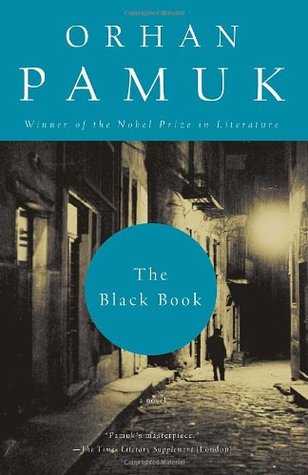The Black Book by Orhan Pamuk (Book Review)

There are two types of Pamuk novels: his post-modernist types (My Name is Red and Snow) and his more realist-type novels (Silent House and Museum of Innocence). The Black Book belongs to the former category and is one of his best works from an artistic perspective. It contains the usual Pamuk flourishes: repetitive and melancholic descriptions of Istanbul, wives that are both beautiful and bored, and a highly dynamic narrative style.[1] At first, the novel provides a vignette into the uninteresting lives Galip (the protagonist of the novel) and his beautiful Rüya along with their respective family dynamics. Galip has inherited a legal practice from his family, and while he is good at his job, he is not taken with his life. Rüya’s situation is characterized almost only ennui, as she spends her days smoking cigarettes and reading low-brow mystery novels. When Rüya fails to show up for a family dinner party where the same stultifying conversations are had each week, Galip goes home to find a note from his wife saying she has left, but she provides no explanation as to why. Galip decides not to inform his family or friends of her disappearance but instead seek her out independently. At the same time Galip’s much older uncle Celal[2] has gone missing. Celal, while being the black sheep of the family, has nevertheless established himself as one of Turkey’s most popular columnist.
While it took me a few chapter’s to realize this, The Black Book alternates chapters between Galip’s narrative perspective and columns written by Celal. The columns that Celal writes are highly artistic and make for some of the most poetic writings in the Black Book. Here is a taste of a classic Pamukian run-on sentence:
I speak of shantytowns and shacks, bars, nightclubs, and amusement arcades, of rusty horsedrawn Lunaparks, of brothers, mosques, and Dervish lodges, of nests where Marxist splinter groups go to hatch their young, and rogue plastics factories turn out nylon stockings for the black market.
Or this:
There was all variety of ordure in these basement passageways, things so disgusting they cried out for their own words: the shells of pigeon eggs stolen by rats who used the spouts to penetrate the upper stories, unlucky forks and tablecloths, orphaned socks shaken from the folds of sleepy bedsheets, dustcloths, cigarette ends, shards of glass from broken windows, crushed lightbulbs, shattered mirrors, rusty bedsprings, the armless torsos of pink baby dolls whose long-lashed eyes continued to open and close with hopeless obstinacy, deflated balls, soiled children’s underwear, the carefully shredded remains of suspect magazines, dubious newspapers, and photographs too fearsome to contemplate…
Below I provide readings of two of Celal’s articles: When the Bosphorus Dries Up and The Executioner and the Weeping Face.
When the Bosphorus Dries Up
The Executioner and the Weeping Face
As the novel progresses the storyline and motivations of the characters becomes increasingly convoluted. Galip begins to suspect that Rüya and Celal have disappeared together and hunts down Celal’s secret apartment. Unable to find him there, Galip begins to assume the identity of Celal and begin writing his columns. As the novel progresses, the interactions between different characters begin to take on a fantastical and implausible dimension. Mysterious callers ring Celal’s flat, and Galip has long conversations with seemingly omniscient fans who know every detail of Celal’s columns and his writings. These caller’s believe that Celal has uncovered hundred-year long conspiracies are prophesized the coming messiah that will save Turkey from ignominy and decay.
Identity is the idea at the heart of The Black Book. There is of course the changing identity of Galip as he becomes more like Celal and writes columns that are equally as good. There is Rüya’s mysterious identity as Galip realizes he is unsure of his wife’s motivations for leaving him. Celal is almost totally mysterious with his secret apartment and phone numbers and names. On a meta-level there is the identity of modern Turkey. Throughout the novel, Pamuk via Galip makes references to both Rumi and Dostoyevsky with equal frequency showing the pull between Turkey’s respect its history with a desire to be more like the West.
Pamuk also shows the importance of conspiracy in the cultural history of Ottoman empire and especially Istanbul. While conspiracy-thinking is usually associated with an unsavory fringe in the West, in cities such as Istanbul or Cairo, the general assumption is that hidden forces are at play in daily political life. This is informed by both history and the city scape. Consider the history of the throne-succession in the Ottoman empire until the 17th century: upon the death of the Ottoman Sultan, all of the eligible brothers/sons would race to Istanbul and murder all opposing rivals.[3] Conspiratorial court politics were absolutely necessary to secure power. The very existence of the Turkish state was driven by a small cabal of Young Turks let my Kemal Atatürk. More recently, Erdogan has been firing civil servants en masse throughout the military, judiciary, and key administrative posts under the pretense that they are secret Gulenists. While this is almost certainly a means for Erdogan to establish political control, it nevertheless speaks to the nature of Turkish politics and society that throughout the state apparatus there could be “shadowy” forces at play. Cities like Istanbul retain their medieval character, and in this Byzantine labyrinth of streets and alleys, graveyards and fog, the entire city seems to swirl with intrigue.[4]
By the end of the story, we are still curious as to what has become of Rüya and Celal, but other developments have shifted the focus from a mere missing persons report to an existential identity crisis for Galip and the country as a whole. While there is no satisfying conclusion to this novel, this is to be expected given the impossibility of reconciling the political and cultural contradictions at the heart of Turkish identity. For Pamuk fans The Black Book will be thoroughly enjoyed and should be recommended as his best post-modernist work.
You’ve been wandering around the ghost streets, haven’t you? Seeking out shady deals, strange mysteries, phantoms, people who’ve been dead for a hundred and twenty years, combing through mosques with broken minarets, ruins, condemned houses, abandoned dervish lodges, consorting with swindlers and heroin dealers, decking yourselves out in gruesome disguises, masks, these glasses … am I right? Because Galip Bey – my son – you’ve changed so much since I last saw you. Your face is pale and your eyes have sunk way back in your skull; you’ve become someone else. Istanbul nights are endless; a ghost with a guilty conscience cannot sleep.
